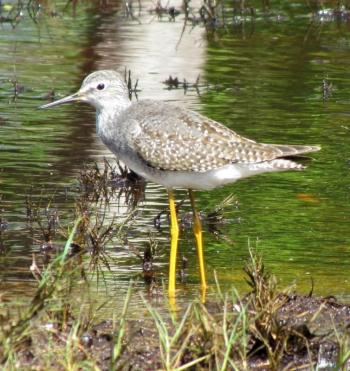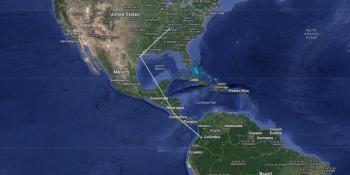Yellowlegs Making Heroic Journeys
A few days ago, our favorite “pop-up pond” played host to a flock of six lesser yellowlegs. These long-legged birds of the sandpiper family move through Maine in April and early May on their way north to the Boreal Forest of Canada and Alaska. Lesser yellowlegs, like their close relatives, greater yellowlegs and solitary sandpiper, in the breeding season occur nowhere else but the region that extends from Alaska across Canada to Newfoundland and Labrador. They nest only within the carbon-rich peatlands that make the Boreal Forest one of the richest wetland regions in the world.
Beginning in July and extending into the fall, lesser yellowlegs leave their northern breeding grounds and begin appearing again in southern Canada and the United States, including right here in Maine. They tend to be found in small numbers across much of the country both at inland wetlands and along the Atlantic, Pacific, and Gulf Coasts. Some spend the winters in the southern U.S. but many eventually make their way to Central America, the Caribbean, and South America. During our cold winters, some are spending their days in the southern hemisphere as far south as Chile and Argentina, where it is actually summer.
While lesser yellowlegs are a widespread and familiar bird, there is much we don’t know about their biology and status. Historically they were a commonly hunted bird here in the United States prior to enactment of the Migratory Bird Treaty Act in the early 1900s. Their numbers were thought to have greatly suffered during that time. Today, sadly, lesser yellowlegs are still hunted in parts of the Caribbean and in a few locations in South America.
To help increase our knowledge of lesser yellowlegs, a new study was started just last month by Audubon Americas and Selva, a local partner organization in Colombia. Ten lesser yellowlegs were fitted with small radio transmitters in early April in some wetlands within the agricultural region of the Cauca Valley of Colombia. Amazingly, four of the birds have already been detected at receiver stations that are part of what’s called the MOTUS network, as they made their migratory movements north. Two passed over a station in the mountains of northwestern Costa Rica during the early morning hours of May 1st. Even more incredible, another of the tagged lesser yellowlegs was detected flying over Costa Rica on April 30th and then was detected 36 hours later in Texas—a distance of more than 1300 miles! To top it all off, the bird apparently kept going and made it to Tennessee about 14 hours later. It is thought that the bird may have flown nonstop for at least 50 hours. Imagine that!
Two of the other birds tagged in Colombia have headed up through the central U.S. with one stopping in Nebraska and another in Kansas.
We can’t wait to learn more about these amazing birds and their journeys and, hopefully, to learn more about where in the Boreal Forest they will go to nest!
Jeffrey V. Wells, Ph.D., is a Fellow of the Cornell Lab of Ornithology and Vice President of Boreal Conservation for National Audubon. Dr. Wells is one of the nation's leading bird experts and conservation biologists and author of the “Birder’s Conservation Handbook.” His grandfather, the late John Chase, was a columnist for the Boothbay Register for many years. Allison Childs Wells, formerly of the Cornell Lab of Ornithology, is a senior director at the Natural Resources Council of Maine, a nonprofit membership organization working statewide to protect the nature of Maine. Both are widely published natural history writers and are the authors of the popular books, “Maine’s Favorite Birds” (Tilbury House) and “Birds of Aruba, Bonaire, and Curaçao: A Site and Field Guide,” (Cornell University Press).





























